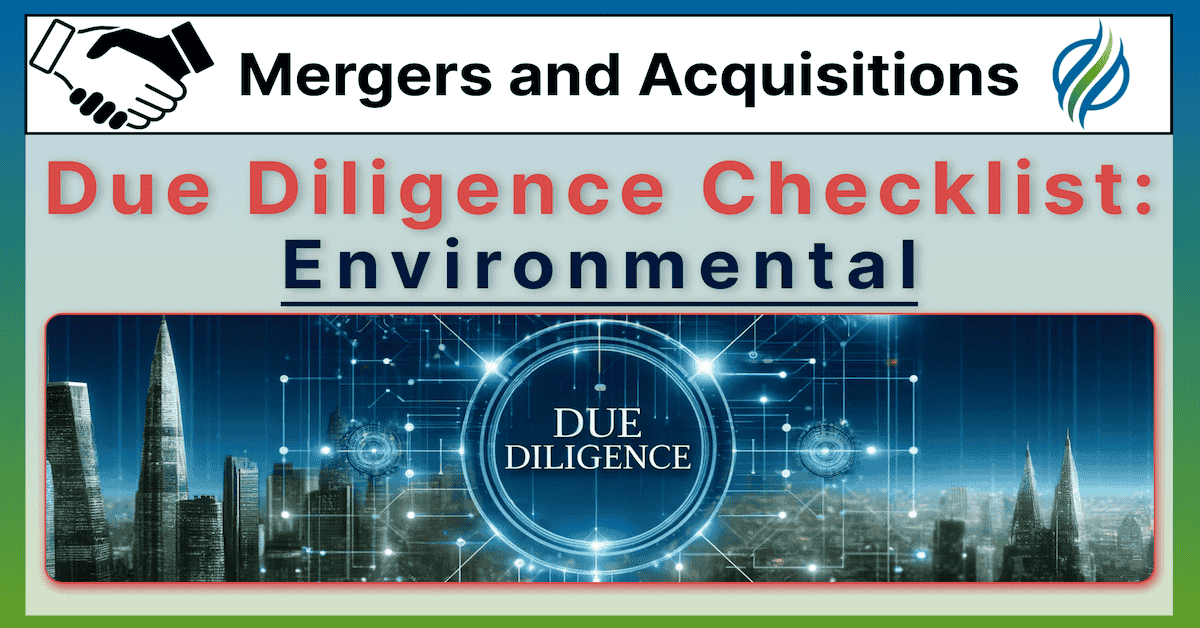Navigating mergers and acquisitions can be complex, especially when environmental issues come into play.
This article breaks down the essential steps for conducting thorough environmental due diligence.
Understanding these steps is crucial to ensure compliance, identify potential risks, and protect your investment.
 Key Takeaways
Key Takeaways
- Identify Environmental Liabilities: Conduct thorough reviews of environmental audits and reports to uncover any existing liabilities.
- Ensure Regulatory Compliance: Verify that all necessary environmental permits and licenses are in place and current.
- Assess Hazardous Substances: Evaluate the use and management of hazardous substances to prevent environmental risks.
- Review Legal Issues: Investigate any ongoing or past environmental litigation and claims to understand potential liabilities.
- Analyze Long-term Risks: Identify any Superfund exposure and contingent liabilities for comprehensive risk assessment.
Why is this important?
Environmental liabilities can significantly impact your business’s financial and operational health.
Ignoring these risks can lead to costly legal battles and regulatory fines.
This guide provides practical steps, benefits, and expert insights to help you make informed decisions.
To get the most out of this article, take note of the practical steps outlined in each of the following sections.
These steps are designed to be actionable and straightforward.
Use the self-assessment questions to evaluate your current processes and identify areas for improvement.
Utilize the links to additional resources for deeper understanding and further guidance.
Ready to dive in?
Continue reading to ensure your M&A process is environmentally sound and legally compliant.
 Table of Contents
Table of Contents
Environmental due diligence is a crucial component in mergers and acquisitions, particularly for companies whose operations may have significant environmental impacts.
This process involves a comprehensive review of the target company’s compliance with environmental regulations, as well as the identification of any potential environmental liabilities.
Understanding these factors is essential for assessing risks, ensuring regulatory compliance, and avoiding unforeseen financial burdens post-acquisition.

➤ MORE: Check out the FULL Due Diligence Checklist here
Review Environmental Audits and Reports:
Environmental audits and reports provide a detailed account of the target company’s environmental practices and compliance status.
These documents are essential for identifying existing environmental issues or liabilities that may impact the valuation and integration of the target company.
Reviewing these audits helps to uncover any past violations, ongoing compliance issues, and areas requiring remediation.
Practical Benefits:
-
Identifies existing environmental liabilities.
-
Assesses the target company’s compliance with environmental laws.
-
Helps avoid unforeseen costs associated with environmental remediation.
Importance:
-
Ensures awareness of potential environmental risks.
-
Protects against future legal and financial repercussions.
-
Informs strategic decisions regarding the acquisition.
Practical Steps:
-
Request Environmental Audits: Obtain comprehensive environmental audits from the target company. Review these documents to identify any significant findings and compliance issues.
-
Analyze Reports: Examine reports detailing past and current environmental practices, focusing on areas of non-compliance or ongoing remediation efforts.
-
Consult with Environmental Experts: Engage environmental consultants to interpret the findings and provide insights into potential risks and liabilities.
Self-Assessment Questions:
-
Are there any significant findings in the environmental audits?
-
How frequently are environmental audits conducted?
-
What steps has the company taken to address any issues identified?
-
Are there any pending environmental investigations?
Links to Resources:
-
Environmental Protection Agency (EPA): For U.S. environmental compliance.
-
Environmental Audits and Reports: Provided by the target company.
-
Environmental Consultants Directory: For professional assessments.
Assess Hazardous Substance Use:
The use of hazardous substances in a company’s operations poses significant environmental risks and regulatory compliance challenges.
A thorough review of how these substances are managed and disposed of is crucial for understanding the potential environmental impact and liabilities.
Practical Benefits:
-
Identifies potential environmental risks associated with hazardous substances.
-
Ensures compliance with hazardous substance regulations.
-
Helps prevent environmental contamination and related liabilities.
Importance:
-
Reduces the risk of regulatory penalties.
-
Protects the acquiring company from inheriting environmental liabilities.
-
Provides a clear understanding of the target company’s operational practices.
Practical Steps:
-
Inventory Hazardous Substances: Request a detailed list of all hazardous substances used by the target company. Review the types, quantities, and purposes of these substances.
-
Review Handling Procedures: Examine the company’s procedures for managing and disposing of hazardous substances. Ensure that these practices comply with relevant regulations.
-
Assess Training Programs: Verify that employees handling hazardous substances receive proper training and that safety protocols are in place to prevent accidents and contamination.
Self-Assessment Questions:
-
What hazardous substances does the company use?
-
How does the company manage and dispose of these substances?
-
Are there any compliance issues related to hazardous substance use?
-
What measures are in place to prevent environmental contamination?
Links to Resources:
-
OSHA Hazardous Substances: For regulatory guidelines and compliance.
-
Environmental Protection Agency (EPA) Hazardous Waste: For disposal and management practices.
-
Safety Data Sheets (SDS): For detailed information on hazardous substances.
Evaluate Environmental Permits and Licenses:
Environmental permits and licenses are legal requirements for many businesses, ensuring that their operations meet environmental standards.
Evaluating these documents helps confirm that the target company adheres to all necessary regulations, minimizing the risk of non-compliance penalties.
Practical Benefits:
-
Verifies regulatory compliance.
-
Identifies any potential legal issues related to environmental permits.
-
Ensures continuity of operations post-acquisition.
Importance:
-
Prevents delays or shutdowns due to permit violations.
-
Reduces the risk of inheriting non-compliance issues.
-
Provides a clear view of the regulatory landscape the target company operates within.
Practical Steps:
-
Obtain Permits and Licenses: Request copies of all environmental permits and licenses from the target company. Review these documents to ensure they are current and valid.
-
Check Compliance History: Investigate the company’s history of compliance with these permits. Look for any past violations or penalties.
-
Verify Renewal Processes: Confirm that the company has processes in place for the timely renewal of permits and licenses. Ensure there are no impending expirations that could disrupt operations.
Self-Assessment Questions:
-
Are all required environmental permits and licenses in place?
-
Are there any issues or violations related to these permits?
-
How frequently are permits and licenses reviewed and renewed?
Links to Resources:
-
EPA Environmental Permits: For understanding permit requirements and processes.
-
State Environmental Agencies: For state-specific permit information.
-
Environmental Compliance Assistance: For small businesses.
Review Environmental Litigation and Claims:
Environmental litigation and claims can significantly impact a company’s financial and operational stability.
Reviewing these aspects helps identify potential liabilities and the company’s ability to manage environmental issues effectively.
Practical Benefits:
-
Identifies potential legal liabilities.
-
Assesses the financial impact of ongoing or past litigation.
-
Informs the negotiation process by highlighting risks.
Importance:
-
Reduces the risk of inheriting costly legal issues.
-
Provides insights into the company’s approach to managing environmental disputes.
-
Ensures comprehensive risk assessment.
Practical Steps:
-
Gather Litigation Records: Obtain records of any environmental litigation, claims, or investigations involving the target company. Review these documents for details on the nature and status of each case.
-
Assess Financial Impact: Analyze the potential financial impact of any ongoing or past litigation. Consider settlement costs, legal fees, and potential fines.
-
Review Remediation Efforts: Investigate the steps the company has taken to address past environmental issues. Ensure that adequate measures are in place to prevent recurrence.
Self-Assessment Questions:
-
Are there any ongoing environmental litigation or claims?
-
What is the potential financial impact of these claims?
-
How has the company addressed past environmental issues?
-
Are there any significant risks related to pending investigations?
Links to Resources:
-
Environmental Law Institute: For information on environmental law and litigation.
-
Environmental Protection Agency (EPA) Enforcement: For understanding enforcement actions and penalties.
-
Legal Databases: For accessing litigation records and case details.
Analyze Superfund Exposure and Contingent Liabilities:
Superfund sites and contingent environmental liabilities can pose significant long-term risks for an acquiring company.
Analyzing these exposures is essential for understanding the potential financial and operational impacts on the business.
Practical Benefits:
-
Identifies long-term environmental risks.
-
Assesses the financial implications of remediation efforts.
-
Provides a comprehensive view of potential contingent liabilities.
Importance:
-
Protects against inheriting substantial cleanup costs.
-
Ensures awareness of ongoing remediation obligations.
-
Informs risk management strategies.
Practical Steps:
-
Identify Superfund Sites: Determine if the target company has any known Superfund exposure. Review records from the EPA or other relevant agencies.
-
Evaluate Financial Impacts: Assess the potential financial impact of these exposures, including cleanup costs and ongoing monitoring expenses.
-
Review Management Strategies: Investigate how the company has managed contingent environmental liabilities in the past. Ensure that effective strategies are in place to handle future risks.
Self-Assessment Questions:
-
Does the company have any known Superfund exposure?
-
What are the potential financial impacts of these exposures?
-
How has the company managed contingent environmental liabilities?
-
Are there any ongoing remediation efforts?
Links to Resources:
-
Superfund Site Information: For details on Superfund sites and cleanup efforts.
-
Environmental Financial Advisory Board: For guidance on managing environmental financial risks.
-
Environmental Risk Management: For strategies on managing environmental liabilities.
FAQs - Frequently Asked Questions About Environmental Due Diligence

What is environmental due diligence in M&A?
It's the process of evaluating environmental risks and compliance in a merger or acquisition.
Learn More...
Environmental due diligence involves assessing the target company's adherence to environmental laws, identifying potential liabilities, and evaluating risks related to hazardous substances, permits, and past litigation.
This process helps prevent costly legal issues and ensures the acquiring company is aware of any environmental responsibilities they may inherit.
Why is reviewing environmental audits important in M&A?
It identifies existing environmental issues and ensures compliance.
Learn More...
Reviewing environmental audits provides detailed insights into the target company's environmental practices and compliance status.
These audits can reveal past violations, ongoing issues, and areas needing remediation, which are crucial for assessing risks and preventing future liabilities.
This review helps in making informed decisions and avoiding unexpected costs post-acquisition.
How can hazardous substance use impact an acquisition?
Improper management can lead to significant environmental risks and liabilities.
Learn More...
Hazardous substances pose serious environmental and health risks if not managed correctly.
During an acquisition, understanding how these substances are handled is vital.
It ensures compliance with regulations, prevents potential contamination, and avoids legal penalties.
Proper management reflects the company's commitment to safety and environmental responsibility.
Evaluating hazardous substance use helps mitigate risks associated with storage, disposal, and accidental spills, safeguarding both the environment and the acquiring company's reputation.
What are the consequences of not having proper environmental permits?
It can result in fines, operational delays, and legal issues.
Learn More...
Operating without the necessary environmental permits exposes a company to regulatory penalties, potential shutdowns, and significant legal challenges.
It indicates non-compliance with environmental laws, which can affect the valuation and integration process in an acquisition.
Ensuring all required permits and licenses are in place is essential for maintaining legal operations and avoiding costly disruptions.
How do environmental litigation and claims affect M&A?
They can lead to financial liabilities and operational risks.
Learn More...
Environmental litigation and claims can significantly impact a company's financial stability and operational continuity.
Identifying ongoing or past legal issues helps assess potential financial impacts, including settlements, fines, and legal fees.
This information is crucial for evaluating the true cost of the acquisition and making informed decisions.
Understanding how the target company has managed these issues provides insights into their risk management practices and future liabilities.
What is Superfund exposure and why is it significant?
It indicates long-term environmental cleanup responsibilities.
Learn More...
Superfund exposure refers to a company's involvement with contaminated sites requiring long-term cleanup under the Superfund program.
This exposure can lead to substantial financial obligations for remediation efforts.
Identifying such liabilities is crucial for assessing the long-term risks associated with an acquisition.
Evaluating Superfund exposure helps ensure that the acquiring company is prepared for potential cleanup costs and regulatory requirements, protecting their investment.
How can environmental due diligence protect my investment?
It helps identify and mitigate environmental risks and liabilities.
Learn More...
Conducting thorough environmental due diligence provides a comprehensive understanding of the target company's environmental compliance and potential liabilities.
This process helps identify risks early, ensuring informed decision-making and preventing costly surprises post-acquisition.
By addressing these issues proactively, you safeguard your investment and ensure a smoother integration process.
Environmental due diligence also demonstrates a commitment to sustainability and responsible business practices, which can enhance your company's reputation and stakeholder confidence.
What are practical steps for conducting environmental due diligence?
Request audits, review permits, assess hazardous substances, and evaluate litigation.
Learn More...
Start by requesting comprehensive environmental audits and reports from the target company.
Review all environmental permits and licenses to ensure they are current and compliant.
Assess the use and management of hazardous substances, and investigate any ongoing or past environmental litigation.
Consulting with environmental experts can provide additional insights and help you navigate complex regulations.
Following these steps will help you identify potential risks, ensure compliance, and make informed acquisition decisions.
What resources are available for environmental due diligence?
EPA, OSHA, and environmental consultants offer valuable resources.
Learn More...
The Environmental Protection Agency (EPA) provides guidelines on environmental compliance and audits.
The Occupational Safety and Health Administration (OSHA) offers resources on hazardous substances management.
Engaging with environmental consultants can provide professional assessments and tailored advice.
Utilizing these resources ensures thorough due diligence and helps you stay informed about regulatory requirements.
Additional resources like legal databases and state environmental agencies can offer further information on compliance and litigation records.
In Summary…
Conducting environmental due diligence in mergers and acquisitions is essential for identifying and mitigating potential environmental risks.
This comprehensive guide has outlined the critical steps you need to take, from reviewing environmental audits and reports to assessing hazardous substance use, evaluating permits and licenses, examining legal issues, and analyzing long-term liabilities such as Superfund exposure.
By applying the information in this article, you gain a clear understanding of your target company’s environmental standing.
This helps you avoid costly surprises, ensure regulatory compliance, and make informed decisions that protect your investment.
Proper environmental due diligence minimizes legal and financial risks, paving the way for a smoother acquisition process.
In practical terms, you will:
-
Identify potential environmental liabilities early to avoid future legal battles and financial burdens.
-
Ensure all necessary permits and licenses are current, preventing operational disruptions.
-
Assess and manage hazardous substances effectively to maintain compliance and safety.
-
Understand the impact of any ongoing or past environmental litigation, helping you prepare for any financial implications.
-
Evaluate long-term environmental risks, providing a comprehensive risk management strategy.
Taking these steps will enhance your decision-making process, ensuring that you acquire a company with a solid environmental record or are prepared to address any issues that arise.
Ready to take the next step?
Schedule a consultation call with Business Initiative or use our contact form to learn more about how we can assist you with your M&A due diligence.
Stay informed with our latest updates by subscribing to the Initiative Newsletter.
Don’t forget to follow us on X for real-time insights and tips on successful business strategies.
Sources
- Environmental Protection Agency (EPA): For U.S. environmental compliance.
- Environmental Audits and Reports: Provided by the target company.
- Environmental Consultants Directory: For professional assessments.
- OSHA Hazardous Substances: For regulatory guidelines and compliance.
- EPA Hazardous Waste: For disposal and management practices.
- Safety Data Sheets (SDS): For detailed information on hazardous substances.
- EPA Environmental Permits: For understanding permit requirements and processes.
- State Environmental Agencies: For state-specific permit information.
- Environmental Compliance Assistance: For small businesses.
- Environmental Law Institute: For information on environmental law and litigation.
- EPA Enforcement: For understanding enforcement actions and penalties.
- Legal Databases: For accessing litigation records and case details.
- Superfund Site Information: For details on Superfund sites and cleanup efforts.
- Environmental Financial Advisory Board: For guidance on managing environmental financial risks.
- Environmental Risk Management: For strategies on managing environmental liabilities.


